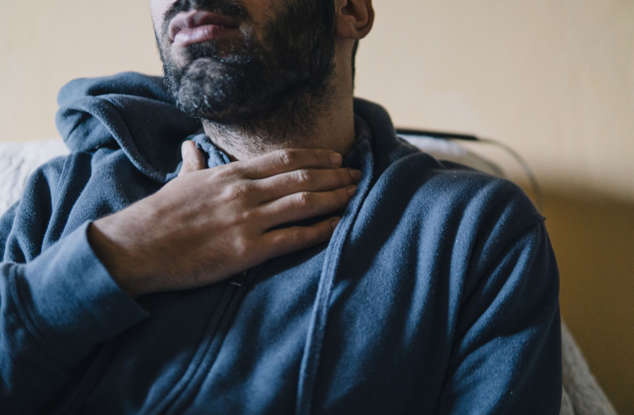by Kali Coleman
COVID cases in the U.S. are still at an all-time high, with more than a 33 percent increase in infections this week compared to last, per the Centers for Disease Control and Prevention (CDC). From new cases to breakthrough infections and reinfections, the Omicron variant is estimated to account for 98 percent of current cases, according to the agency. This version of the virus is spreading faster than any previous COVID variant, and it’s hitting people differently as well. There are a number of symptoms that virus experts have warned are distinct with Omicron, including what your first sign might be. Read on to find out the earliest Omicron symptom to expect.
A sore throat could be the first sign of an Omicron infection.
A sore throat was reported as a common symptom of some previous COVID variants, but with Omicron, doctors say it’s likely to be your first. “For most people, an Omicron positive case will feel much more like the common cold, starting with a sore throat,” Tim Spector, a professor of epidemiology at King’s College London and founder of the Zoe COVID Symptom Study, told the BBC in December.
This common symptom might be even be more recognizable in certain groups of people infected with Omicron. Allison Arwady, MD, the commissioner for the Chicago Department of Public Health, told NBC 5 Chicago that while sore throat is being seen early across the board, it is being seen most often as an indicator of Omicron in people who are vaccinated or boosted.
“In people who we’re seeing these more mild breakthrough infections, we are definitely seeing sore throat be a predictor in that group,” Arwady said.
This symptom is very prominent in its presentation.
A sore throat can be a indicator of a number of illnesses, but an Omicron sore throat is distinctive. Jorge Moreno, MD, an internist and assistant professor of medicine at Yale School of Medicine, told Insider in early January that when his outpatient clinic in Connecticut exploded with new Omicron infections, many of his patients were reporting the same initial symptom: a dry, sore throat that caused sharp pain when they swallowed.
“It’s a very prominent symptom,” Moreno told the news outlet. “It’s not like a little tickle in the throat. If they’re reporting it, they’re saying that their throat feels raw.”
This is just one of the most common symptoms of this variant.
A sore throat is just one of many symptoms you might experience with Omicron. According to data from Spector’s Zoe COVID Study App, there are five common symptoms being reported with this variant: runny nose, headache, fatigue, sneezing, and sore throat. Runny nose and sneezing haven’t been the most common symptoms with previous variants, but “the most reported symptoms of Omicron are really very much like a cold,” Claire Steves, PhD, a scientist from King’s College London involved with Zoe, confirmed in a Jan. 6 video.
Headache and fatigue have been common symptoms with other strains of the virus, but there might be some clear presentations with this variant. William Schaffner, MD, an infectious disease specialist and professor at the Vanderbilt University School of Medicine, told Prevention that an Omicron headache is “more likely to be frontal,” meaning you’ll feel it in the front of your head rather than the back. And Angelique Coetzee, a private practitioner and chair of South African Medical Association, told Reuters, that severe fatigue with Omicron tends to last for “one to two days.”
Your symptoms will likely start a few days after exposure.
With previous variants, symptoms usually took about four of five days to show up in infected patients. But Ryan Noach, MD, CEO of South Africa’s largest private health insurer, Discovery Health, has said that preliminary research suggests Omicron may have a shorter window, with symptoms from the variant typically showing up three days after exposure, according to The Washington Post.
Doctors also say you should probably wait this long to determine if you’ve been infected after exposure, given the potential shorter incubation period. “If you’ve been exposed and now you’re asking yourself, ‘When should I get tested?’ I think you would best wait at least three days to see if you’ve turned positive,” Schaffner told NBC News.

